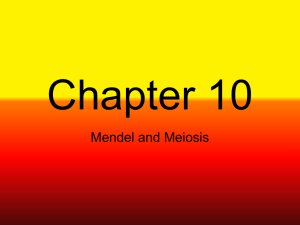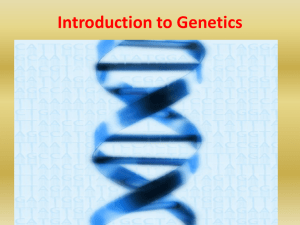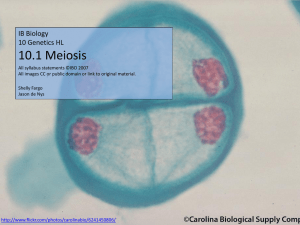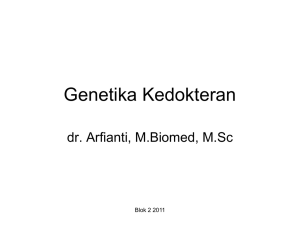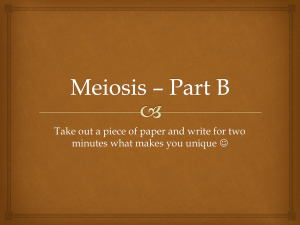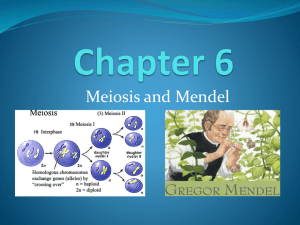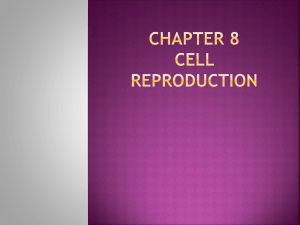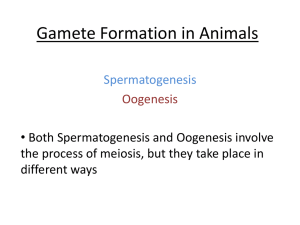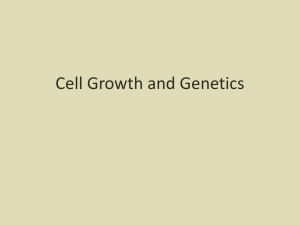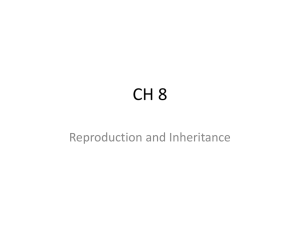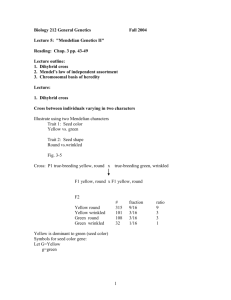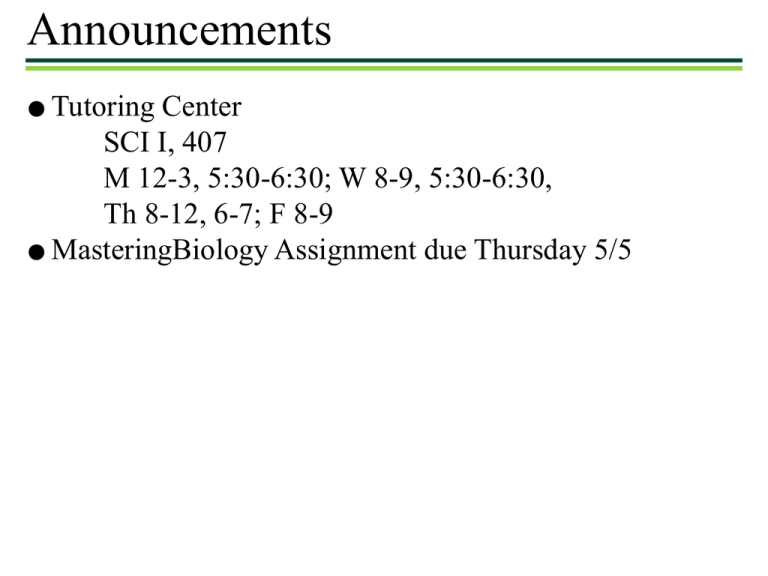
Announcements
● Tutoring
Center
SCI I, 407
M 12-3, 5:30-6:30; W 8-9, 5:30-6:30,
Th 8-12, 6-7; F 8-9
● MasteringBiology Assignment due Thursday 5/5
LM
Phases of Mitosis
(b)
(a)
(c)
(d)
A. Interphase
B. Prophase
B. C. Metaphase D. Anaphase
E. Telophase
Review of Terms
• A somatic cell
Is a typical body cell
Has 46 chromosomes in a human
• A gametic cell (gamete)
Is used for sexual reproduction
Usually termed eggs and sperm
• Haploid – cell or organism that contains one
complete set of chromosomes
• Diploid - cell or organism that contains two complete
sets of chromosomes
Review of Terms
• Autosome
Chromosome that is not directly involved in determining the
sex of an organism
• Sex chromosome
A chromosome that determines whether an
individual is male or female
Male
44
XY
Female
Somatic
cells
44
XX
Meiosis
Sexual reproduction requires fertilization of an egg by a
sperm using a special type of cell division called meiosis.
Meiosis
Chromosomes
duplicate.
Homologous
chromosomes
separate.
Sister
chromatids
separate.
Pair of homologous
chromosomes in
diploid parent cell
Duplicated pair of
homologous
chromosomes
INTERPHASE BEFORE MEIOSIS
Sister
chromatids
MEIOSIS I
MEIOSIS II
Crossing over
Prophase I
of meiosis
Duplicated pair of
homologous
chromosomes
In crossing over:
•Homologous chromosomes
exchange genetic information
Homologous chromatids
exchange corresponding
segments.
•Genetic recombination, Metaphase I
the production of gene
Sister chromatids
combinations different from remain joined at their
centromeres.
those carried by parental Metaphase II
chromosomes, occurs
Chiasma, site of
crossing over
Spindle
microtubule
Gametes
Recombinant
chromosomes
combine genetic
information from
different parents. Recombinant chromosomes
Meiosis
How do we account for genetic variation? Cross over:
*Independent assortment
*Crossing over
*Random fertilization
Independent Assortment:
Mitosis and Meiosis
Errors in Meiosis
NONDISJUNCTION IN MEIOSIS II
NONDISJUNCTION IN MEIOSIS I
Meiosis I
Nondisjunction:
Pair of homologous
chromosomes fails
to separate.
Meiosis II
Nondisjunction:
Pair of sister
chromatids
fails to separate.
Gametes
n1
n1
n–1
Abnormal gametes
Number of
n – 1 chromosomes
n1
n–1
Abnormal gametes
n
n
Normal gametes
Errors in Meiosis
Down Syndrome:
•Is also called trisomy 21
•Is a condition in which an individual has an extra
chromosome 21
•Affects about one out of every 700 children
Genetics
Genetics is the scientific
study of heredity.
Heredity is the
transmission of traits from
one generation to the next.
Genetics
Gregor Mendel
•Worked in the 1860s
•Was the first person to analyze patterns of
inheritance
•Deduced the fundamental principles of genetics
Genetics
Removed
stamens
from purple
flower.
Mendel studied garden
peas because they:
White
Stamens
•Easy to grow
Parents
(P)
Carpel
• Come
in many readily
distinguishable varieties
• Easily
• Can
Pollinated carpel
matured into pod.
manipulated
self-fertilize
Transferred pollen from
stamens of white flower
Purple to carpel of purple
flower.
Planted seeds
from pod.
Offspring
(F1)
Genetics
• A character is a heritable
feature that varies among
individuals.
• A trait is a variant of a
character.
• Each of the characters
Mendel studied occurred in
two distinct forms.
Genetics
P Generation
(true-breading
parents)
Purple flowers
F1 Generation
White flowers
All plants have
purple flowers
Fertilization
among F1 plants
(F1 F1)
F2 Generation
3
4 of plants
have purple flowers
1
4 of plants
have white flowers
Genetics
*genes and alleles
Mendel’s hypotheses (to explain his results)
1. Alternative
versions of genes
(alleles) account for
variation in inherited
characters.
2. For each character,
an organism inherits
two alleles, one from
each parent.
Genetics
3. If two alleles differ,
one is dominant, the
other recessive
4. The two alleles for each
character segregate (separate)
during gamete production.
P:
X
DD
Tall
dd
Dwarf
F1 – all Tall
Tall
Dd
Mendel’s Law of Segregation
Genetics
A Punnett Square predicts the results of a genetic cross
between individuals of known genotype
Tall
P:
DD
Gamete
formation:
D
D
D
D
d
Dwarf
X
dd
d
d
d
d
D
*genotype
d
4/4 are Dd
4/4 are Tall
D
D
d
D
d
*phenotype
*Homozygous
*Heterozygous
Genetics
Dihybrid cross- A genetic cross between two individuals
involving two characters
Example:
P1
GW
X
yellow, round
green, wrinkled
GGWW
ggww
gw
gw
gw
F1
All
yellow, round
GgWw
gw
GW
GW
GW
GW
F1
F1
X
Gw
gW
gw
GW
Gw
All
yellow, round
All
yellow, round
GgWw
GgWw
F2
9/16 yellow, round
gW
gw
9:3:3:1 Phenotypic ratio; Genotypic ratio as follows:
1/16 GGWW, 2/16 GGWw, 2/16 GgWW, 4/16 GgWw
3/16 yellow, wrinkled
1/16 GGww, 2/16 Ggww
3/16 green, round
1/16 ggWw, 2/16 ggWw
1/16 green, wrinkled
1/16 ggww
Genetics
Mendelian inheritance is based on probability
F1 Genotypes
Example- coin toss
Bb female
*1/2 chance landing heads
Bb male
Formation of sperm
Formation of eggs
F2 Genotypes
*Each toss is an independent event
*Coin toss, just like the
distribution of alleles into gametes
1
2
Female gametes
*The rule of multiplication –
determines the chance that two or
more independent events will occur
together
½x½=¼
Male gametes
1
2
1
2
B
B
b
1
2
B
B
1
4
( 12 12
B
b
1
4
b
B
b
1
4
)
b
b
1
4
Genetics: Pedigrees
First generation
(grandparents)
Ff
Second generation
(parents, aunts, and FF ff
uncles)
or
Ff
Third generation
(brother and
sister)
Female Male
Attached
Free
ff
Ff
ff Ff
Ff
ff
ff
FF
or
Ff
Ff
Human Disorders
Variations in Mendel’s Laws
In incomplete dominance,
F1 hybrids have an
appearance in between the
phenotypes of the two
parents.
P Generation
White
rr
Red
RR
Gametes R
r
F1 Generation
Pink
Rr
1
Gametes 1
R
2 2 r
F2 Generation
Sperm
1
1
R
2 r
2
1
2R
Eggs RR Rr
1 r
Rr rr
2
Variations in Mendel’s Laws
Hypercholesterolemia
PHENOTYPE
GENOTYPE
•Dangerously high levels of cholesterol in the blood.
•Is a human trait that is incompletely dominant.
•Heterozygotes have blood cholesterol levels about 2X normal.
•Homozygotes have blood cholesterol levels about 5X normal.
HH
Homozygous
for ability to make
LDL receptors
Hh
Heterozygous
hh
Homozygous
for inability to make
LDL receptors
LDL
LDL
receptor
Cell
Normal
Mild disease
Severe disease
Variations in Mendel’s Laws
Multiple Alleles
Blood
Group
Genotypes Red Blood Cells
(Phenotype)
Carbohydrate A
IAIA
A
or
IAi
B
IBIB
or
IBi
AB
IAIB
O
ii
Carbohydrate B
Variations in Mendel’s Laws
– Pleiotropy is the impact of a single gene on more than one
character.
Single
gene
Pleiotropy
Multiple traits
(e.g., sickle-cell
disease)
Variations in Mendel’s Laws
Variations in Mendel’s Laws
– Polygenic inheritance is the additive effects of two
or more genes on a single phenotype.
Polygenic
inheritance
Multiple genes
Single trait
(e.g., skin color)
Variations in Mendel’s Laws
P Generation
aabbcc
AABBCC
(very light) (very dark)
F1 Generation
F2 Generation
1
8
1
8
1
8
1
8
1
Eggs 8
1
8
1
8
1
8
1
8
1
64
AaBbCc
AaBbCc
Sperm
1 1 1 1 1 1
8 8 8 8 8 8
1
8
20
64
1
64
6
64
15
64
15
64
6
64
Sex Linkage
*1909 Thomas Hunt Morgan
II
III
XY
IV
or
XX
*Sex chromosomes
*Autosomes
Example: In Drosophila and all mammals
sex chromosomes designated as X and Y
XX=female
XY=male
Sex Linkage
Any gene located on a sex chromosome is called a
sex-linked gene.
• Most sex-linked genes are found on the X chromosome.

